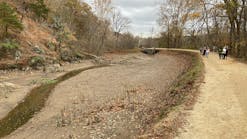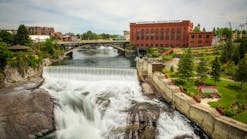About the author:
Paul Eger is environmental engineer for Global Minerals Eng. Chad Wiggins is environmental engineer for Catchment Solutions LLC. Peggy Jones is vice president, sales and research, and Doug Green is president and CEO of American Peat Technology. Eger can be reached at 218.969.6483, Wiggins can be reached at 253.255.6522 and Jones can be reached at 218.927.1888.
Paul Eger, Chad Wiggins, Peggy Jones & Doug Green
undefinedThe process of galvanizing to prevent rust and increase the lifetime of steel was developed in France in 1837. Galvanized roofs are widely used on industrial facilities because of their strength, durability and cost. The zinc coating preferentially weathers and protects the underlying steel, but in the weathering process, zinc is released.
The zinc that is released as the roof ages is washed off by rain and melting snow and can cause elevated zinc concentrations in storm water runoff. To protect fishery resources, zinc is tightly regulated in Oregon and Washington. A low-cost method–an upflow drum filter (UDF)–was developed to treat roof runoff using peat sorption media and drums.
The Technology
A UDF is constructed from a 55-gal drum, which is plumbed into the downspout. Each unit can treat approximately 0.1 acre of roof. Water is collected in the downspout and passes through a screen to remove large particles, leaves and various types of debris prior to entering a coiled perforated hose imbedded in gravel at the bottom of the UDF. Water then flows upward through the media. The system can periodically be backwashed by opening the flush valve at the base of the filter.
Peat also is used for this process. Peat is a natural material and has long been known for its ability to remove metals from water. Natural peat, though relatively inexpensive, tends to be nonuniform, difficult to handle and has poor flow properties. Typically, raw peat has a hydraulic conductivity two-to-three orders of magnitude lower than coarse sand. These lower conductivities reduce the overall flow rate, increase the potential for channelization and make deployment as a treatment media difficult.
American Peat Technology (APT), a peat harvester in central Minnesota, developed a granulation and low-temperature hardening process to convert raw peat into an engineered sorption media. The granular media maintains its structure when wet and can be produced in a variety of sizes to meet the specifications of individual projects. This scalability is adaptable to a variety of treatment systems.
The media resembles coffee grounds, and the standard granule size is 0.6 to 2 mm. It has an estimated hydraulic conductivity around 0.5 cm per second, both of which are comparable to coarse sand. Despite the processing conditions, the media retains nearly all the metal removal capacity of the raw peat. Total metal removal is a function of solution chemistry, but maximum capacities achieved in laboratory equilibrium tests range from 1% to 15% dry weight.
The Site
An industrial facility in the Pacific Northwest was not meeting benchmarks for zinc and was out of compliance with its storm water permit. The total site was approximately 15 acres and contained approximately 10 acres of paved parking lots and two buildings; a 4-acre warehouse with a tar roof; and a 1-acre warehouse extension with a galvanized roof. The site already had an end-of-pipe treatment system for the entire site, but the removal efficiency was not sufficient to consistently meet the zinc benchmark of 0.117 mg/L. Exceedance had triggered enforcement actions and the company needed to develop a plan to bring the site back into compliance.
To avoid costly retrofits and the expansion of the existing treatment system, the company conducted an overall site evaluation to identify the sources of zinc. Although the warehouse extension was only approximately 6% of the total area, it contributed nearly 40% of the total zinc loading. If this water could be pretreated, the existing treatment system might be able to remove enough zinc to bring the site into compliance. UDFs were installed on each of the 10 downspouts to pretreat the roof runoff.
Reducing Zinc
Zinc concentrations in the roof runoff ranged from 1 to 6 mg/L. This is a range of 10 to more than 50 times the benchmark. The UDFs initially removed more than 90% of the zinc, but removal efficiency slowly decreased as more water was treated. However, by instituting a six-month replacement schedule of the media, high removal efficiencies could be maintained throughout the treatment cycle. As soon as the UDFs were installed, the zinc concentration entering the treatment system dropped by about 50% and benchmarks were met.
Expansion and changes to the overall treatment system had been estimated to be well above $100,000, but the cost for a single UDF treatment unit was approximately $1,000, bringing the total project cost to about $10,000. The simple design and the use of inexpensive, standard materials helps keep the cost low. Treating the roof runoff from the site with the UDFs was about 25% to 33% of the cost of other commercial downspout units.
The use of the UDF with peat sorption media was successful in removing most of the zinc from the roof runoff at a fraction of the cost. Since the UDFs were installed, the site has been in continual compliance. No expensive retrofits, additions or changes to the existing treatment system were required.






